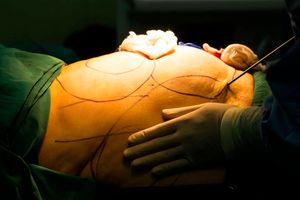Breast self-examination (The complete guide)

Even after your breast self-exam, you will still need to periodically go for medical mammography as advised by your physician.
What you need to know:
- In Kenya, breast cancer is estimated to account for 23 percent of all cancer cases among women.
- Women seeking basic treatment for breast cancer pay between Sh. 175,200 and Sh. 1.98 million without surgery in Kenya, according to the National Cancer Institute.
- In 2020, there were 2.3 million women diagnosed with breast cancer and 685 000 deaths globally. As at the end of 2020, there were 7.8 million women alive who were diagnosed with breast cancer in the past 5 years, according to the World Health Organisation.
According to the Ministry of Health, breast cancer currently accounts for about 6,000 new cases of cancer every year. Symptoms include a lump in the breast, asymmetry, skin retraction, recent nipple retraction, blood-stained nipple discharge, eczematous changes in the areola. The World Health Organization recommends that you consult your physician within one to two months when you find an abnormal lump in your breast, regardless of whether the lump is painful or not.
“Every lump should be checked out by a medical professional because not all lumps are cancerous. As many as 90 percent of breast masses are not cancerous. Non-cancerous breast abnormalities include benign masses like fibroadenomas and cysts as well as infections,” the WHO states.
Women are recommended to periodically carry out a breast self-exam. The primary aim of this exam is to familiarise themselves with the look and feel of their breasts in order to be alert whenever there are any changes such as the presence of a lump. However, a breast self-exam is not to be mistaken for a full screening. Even after your breast self-exam, you will still need to periodically go for medical mammography as advised by your physician. A medical mammogram is a breast X-ray. The Centre for Disease Control recommends that women who are aged 50 to 74 years, and who are at average risk for breast cancer, should go for a mammogram once every two years. Women between 40 to 50 are recommended to consult their physicians before going for a mammogram.
Timing
Choose a time within your menstruation cycle when your breasts are least tender. A breast self-exam guide that was released by Mayo Clinic recommends that you perform a breast self-exam the week after your period has ended. “Each month during your cycle, your hormone levels fluctuate and cause changes in breast tissue. Swelling will begin to decrease when your period starts,” the guide says. Women who no longer experience menstruation, and those who largely have irregular cycles should pick a day each month for the exam.
According to the WHO, there are three steps you should follow for a proper breast self-exam.
Step 1: Put your arms down by your sides. Carefully check if there are any changes in your breast and breast area. These changes include the shape of the breast, swelling of the breast, changes in the nipples, and a form or show of dimples on the skin of the breast. Also, check if any of your nipples have changed position. This might include an inverted nipple or a nipple that has been pushed inwards instead of sticking outwards. Place your hands on your hips firmly such that your chest muscles flex. Examine the same things you have checked on both breasts. Lift your hands high above your head and check for the same things again.
Step 2: Using the pad of your index finger, middle finger, and ring finger, press on every part of each breast. Start by applying light pressure. Slowly apply medium pressure and finally firm pressure. You will be looking to feel lumps and thick spots in your breasts. Use a circular pattern to navigate around the breasts. Once you’re done, examine the dark-coloured skin area on your breast that surrounds your nipples. This area is known as the areola. Narrow down on the nipple and squeeze it slowly and gently to see if there will be any discharge.
Step 3: This involves a manual check while lying down. You will follow the same pattern of examination you used while standing up. Make sure you have covered the entire breast area. This includes the area from your collarbone to the top of your abdomen, and from your armpit to your cleavage. A pattern will ensure that you will cover the whole breast. For instance, you can begin at the nipple and then move in larger and larger circles until you reach the outer edge of the breast. You can also move your fingers up and down vertically, in rows, like you are mowing a lawn. To examine the skin and tissue just beneath, use light pressure. To examine the tissue in the middle of your breasts, use medium pressure. To examine the tissue at the back of your breast, use firm pressure.
Takeaway: Mammography guidelines for older breast cancer survivors
In 2021, the Dana-Farber Cancer Institute announced the first mammography screening guidelines for older adults who have survived breast cancer. The guidelines recommend that routine mammograms for survivors with a life expectancy of under five years should be discontinued. The impact of screening for survivors with a life expectancy of 5 to 10 years should be evaluated before continuation. However, among patients with a life expectancy of over 10 years, routine mammography should be continued. “Mammography in breast cancer survivors of all ages has been based on annual screening. This doesn’t pay attention to the roles of life expectancy, risk of recurrence, and patient preferences,” said Dr. Rachel Freedman who led the team of oncologists in developing the new guidelines.
The guidelines further recommended that mammography for survivors aged 75 years and above should be stopped. “This is due to the low risk that this category of survivors will develop cancer in their breast, the lengthy time needed for the small benefits of mammography to be realised, and the persistence of the negative effects of mammography,” said Dr. Freedman. According to the guidelines, women aged 85 years should not undergo mammography unless their health was good enough or if they preferred to have the screening. The team highlighted the downsides of mammography screening among older people such as false positives, overtreatment, and anxiety associated with diagnostic testing. These guidelines were published in the cancer journal JAMA Oncology. Dana-Farber Cancer Institute is a clinical affiliate and research institute of the Harvard Medical School. The institute is ranked among the top three cancer hospitals in the world.




